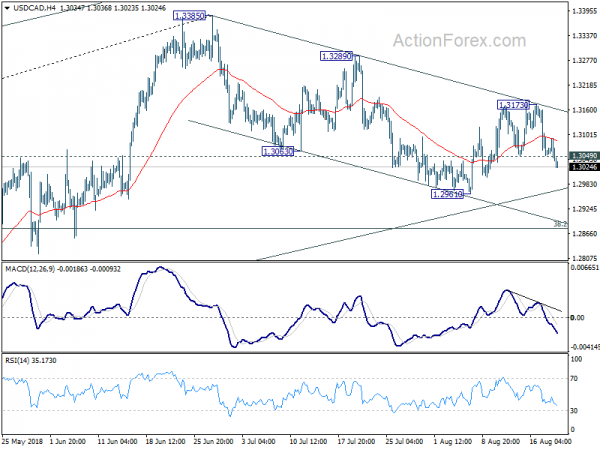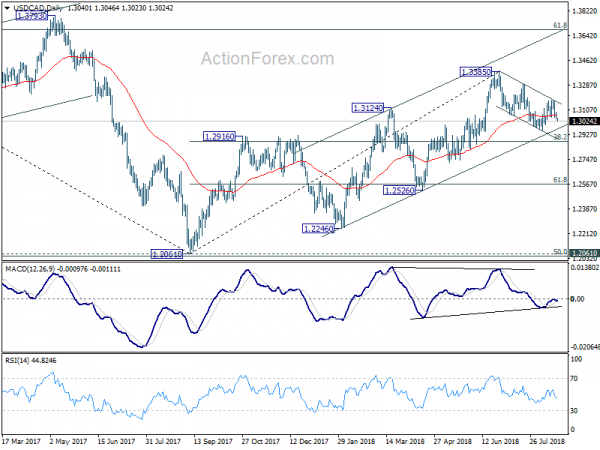Dollar weakens broadly overnight on Trump’s attack on Fed’s policy. It started after Bloomberg reported that Trump lamented Fed chair Jerome Powell for not being the “cheap-money” chair he expected. Then Trump reiterated his comments that he’s “not thrilled” with interest rate hikes in Reuters interview. But this time, Trump hid the fact that rate moves at Fed were collective decision. And he embedded a lie in his language by blaming Powell for “his” raising of interest rates. The comments sent Dollar sharply lower, and the greenback extends decline in against all other major currencies.
Gold rides on Dollar’s weakness and rebounds to as high as 1194.71 so far. It’s having sight on 1200 handle. But technically the key resistance is in 1211.65. Reactions in other markets are muted though. DOW gained 0.35%, S&P 500 rose 0.24% and NASDAQ added 0.48%. Asian markets are also generally higher. At the time of writing, Nikkei is up 0.34%, HK HSI up 0.48%, China Shanghai SSE is up notably by 1.43%, Singapore Strait Times up 0.07%.
Technically, while Dollar is weak, EUR/USD and AUD/USD are far from structural resistance at 1.1745 and 0.7452 respectively. Thus, these two pairs are staying bearish. However, USD/JPY’s fall now puts 109.36 key support in focus and break will indicate medium term reversal. Similarly, USD/CAD’s decline also put 1.2916 support in focus and break will raise the chance of medium term reversal too. If happens, weakness in USD/JPY and USD/CAD could be early signal of more Dollar selloff ahead.
Dollar extends decline as Trump blames Fed Chair Powell for rate hikes
Dollar stays generally weak in Asian session and extends Monday’s selloff, on Trump’s attack on Fed. In a Reuters interview, Trump reiterated his comments last month that “I’m not thrilled with his raising of interest rates, no. I’m not thrilled,” referring to Fed Chair Jerome Powell.
He complained the the US is not getting any support from the Fed during his negotiation with other countries. Trump noted, “we’re negotiating very powerfully and strongly with other nations. We’re going to win. But during this period of time I should be given some help by the Fed. The other countries are accommodated.”
Trump also fingered pointed at Eurozone and China for currency manipulation to give them an advantage over the US on trade. He said . “I think China’s manipulating their currency, absolutely. And I think the euro is being manipulated also.”
On trade dispute with China, Trump said he had “no time frame” for ending it. While the Chinese delegation is arriving the US soon, Trump said he did not “anticipate much” from the discussions.
He emphasized that the resolution will “take time” because “China’s done too well for too long, and they’ve become spoiled. They dealt with people that, frankly, didn’t know what they were doing, to allow us to get into this position.”
Former top treasury official blasts Trump as woefully wide of the mark on Yuan manipulation
Mark Sobel, a former top US Treasury Official criticized Trump’s remark regarding Chinese currency manipulation as “woefully wide of the mark”. And, Trump’s focus on bilateral balances as “silly”. And, to suspect a country of currency manipulation, there are criteria of “material ‘excessive’ current account surplus, an undervalued currency, and ample and rising reserves”.
In an article titled “Trump wide of mark on ‘manipulation‘”, Sobel point to facts that “China’s current account surplus is falling to under 1% of GDP. The renminbi, hit by capital outflows between early 2015 and the end of 2016, rose sharply against the dollar up to April 2018. The renminbi trade-weighted index rose too. Since then, the renminbi has fallen on both measures, but the depreciation reflects the dollar’s strength across the board. There is little evidence of more than scant Chinese foreign exchange market intervention.”
He noted “a currency manipulating country should have a significant current account surplus”. And, “the US Treasury in its foreign exchange reports uses a 3% of GDP threshold.” While a currency manipulating country might also have an “undervalued currency” one should “look at a country’s real effective exchange rate, not its bilateral dollar rate.” Additionally, the country may intervene heavily in the markets, “buying dollars to hold its currency down, resulting in an increase in its foreign reserve holdings.” But there might be “good reasons” to do so such as building up of reserves. There are many useful gauges of reserve adequacy to examine – reserves/GDP; reserves/short-term maturing debt; reserves/imports.
Sobel also completed that “a focus on bilateral balances is silly, even if the US Treasury is required to do so by statute and the president seems obsessed with them. Such an emphasis neglects to consider that certain countries specialize in certain goods and hold comparative advantage in such spheres.”
Mark Sobel is US Chairman of OMFIF. He is a former Deputy Assistant Secretary for International Monetary and Financial Policy at the US Treasury and until earlier this year US representative at the International Monetary Fund.
Fed Bostic pledges not to vote for anything that knowingly inverts yield curve
Atlanta Fed President Raphael Bostic said that Fed is doing well on inflation now, and the economy doesn’t need as much stimulus as it had before. Also, GDP is strong and unemployment is “very, very low” historically”. This part seems to be a bit hawkish. However, Bostic also warned that yield curve is currently “extremely flat” and fed has concerns over the flatness. He went further to emphasize that he won’t vote for anything that knowingly inverts yield curve.
RBA minutes: El Niño risks increased, no strong case for a near term rate move
Minutes of August RBA meeting noted that drought conditions affected the timing of crop harvest. And the “probability of an El Niño event, which would typically be associated with low rainfall in eastern Australia, had increased over 2018″. That implies ” downside risks to the forecasts for farm output and exports.”
Otherwise, the minutes came in basically as expected. They noted that global economic expansion continued but “direction of international trade policy in the United States continued to be a source of uncertainty for the global outlook.”
Australian Dollar had “depreciated a little” against the US dollar. However, “in trade-weighted terms it had remained within its trading range of the previous two years.”
Domestic forecasts were largely unchanged. GDP is projected to be a little above 3% over 2018 and 2019. Inflation would dip “temporarily” in September quarter due to some administered prices. But it’s expected to be at around 2.25% in 2020.
On interest rates, the next move “would more likely be an increase than a decrease”. But there was “no strong case for a near-term adjustment”.
On the data front
New Zealand net migration rose 0.6% mom in July. Swiss will release trade balance in European session. UK will release public sector net borrowing and CBI industrial orders. Later in the day, Canada will release wholesale sales.
USD/CAD Daily Outlook
Daily Pivots: (S1) 1.3022; (P) 1.3058; (R1) 1.3076; More…
USD/CAD drops further to as low as 1.3023 so far today. The break of 1.3049 support suggests that rebound form 1.2961 has completed at 1.3173 already. The pair is also kept well inside near term falling channel. Intraday bias is back on the downside for 1.2961 first. Break there will resume whole decline from 1.3385. More importantly, that will also break medium term channel support firmly and carries larger bearish implications. On the upside, break of 1.3173 is needed to confirm completion of fall from 1.3385. Otherwise, risk will now stay on the downside even in case of recovery.
In the bigger picture, as long as channel support (now at 1.2965) holds, we’re holding to the bullish view. That is, fall from 1.4689 (2015 high) has completed at 1.2061, ahead of 50% retracement of 0.9406 (2011 low) to 1.4689 (2015 high) at 1.2048. Further rally should be seen for 61.8% retracement of 1.4689 to 1.2061 at 1.3685 and above. However, sustained break of the channel support will argue that rise from 1.2061 has completed. Further decline should be seen to 38.2% retracement of 1.2061 to 1.3385 at 1.2879 first. Sustained break will pave the way to 61.8% retracement at 1.2567 and below.
Economic Indicators Update
| GMT | Ccy | Events | Actual | Forecast | Previous | Revised |
|---|---|---|---|---|---|---|
| 22:45 | NZD | Net Migration M/M Jul | 0.60% | -3.50% | -3.60% | |
| 1:30 | AUD | RBA Meeting Minutes Aug | ||||
| 6:00 | CHF | Trade Balance (CHF) Jul | 2.85B | 2.59B | ||
| 8:30 | GBP | Public Sector Net Borrowing (GBP) Jul | -2.1B | 4.5B | ||
| 10:00 | GBP | CBI Industrial Order Expectations | 10 | 11 | ||
| 12:30 | CAD | Wholesale Trade Sales M/M Jun | 0.80% | 1.20% |















